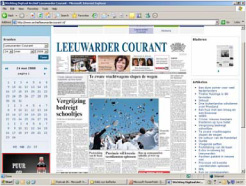in a Public–Private Partnership
This article is based on a presentation at the 2008 Annual General Conference of LIBER. The presentation, including illustrations, can be accessed at: http://www.ku.edu.tr/ku/images/LIBER/eddy_noord.ppt
In a unique public–private partnership between the Frisian historical centre Tresoar and the publishers, the Dutch local newspaper Leeuwarder Courant, the oldest newspaper in the Netherlands, was fully digitised in 2006 and made available online at no cost to the user. With an average of 2 million page views each month, the website is a great success.
The Leeuwarder Courant is the oldest newspaper of the Netherlands, having been published since 1752. It is the main newspaper of the Dutch province Friesland, with a current circulation of 110,000 copies.
In 2005 two important stakeholders developed a plan to digitise the newspaper: the Frisian historical centre ‘Tresoar’ on the one hand, and the Leeuwarder Courant’s publishers on the other hand. Both partners were acutely aware of the cultural heritage value of the paper for Friesland and its inhabitants. By making the paper available online, Tresoar would expand its digital services to its patrons, while at the same time improving facilities for in-house research. The Leeuwarder Courant’s publishers would greatly enhance research facilities for its journalists while strengthening its ties with the paper’s readership. Neither partner, however, could raise enough funds to carry out the project by itself. For the Leeuwarder Courant’s publishers there was no business case, and Tresoar lacked the rights to digitise the paper. Therefore Tresoar and the paper’s publishers joined forces to initiate a project to digitise the paper, preserve it for the long term, and make it freely available online for the whole world.

Figure 1: Leeuwarder Courant in print.
It was decided that the partnership would legally become a public/private foundation under Dutch law, the ‘Stichting Digitaal Archief Leeuwarder Courant’ (SDALC). This solved several problems. The partners’ common view on the importance of digitising cultural heritage could be firmly established in the foundation statutes. Secondly, a foundation can raise money from regional and national funding agencies to supplement substantial contributions from the partners themselves. Thirdly, the publisher formally transferred his copyright for online presentation to the foundation. At present, after more than 500,000 unique visits to the website, not a single claim has been made against the foundation. The foundation’s statutes furthermore guarantee preservation of both the physical and the digital copies.
The project was financed with public and private resources (both regional and national). Yearly exploitation costs (hosting, marketing, new developments) are covered by advertising revenues (google ads, banners) and by selling consumer products (historic front pages, printing-on-demand books — still in development). Added benefits for both stakeholders are more efficient (journalistic) research, no more investment in microfilm readers, smaller documentation departments and, perhaps the most important: more goodwill from the readers of the Leeuwarder Courant.

Figure 2: Leeuwarder Courant online.
The newspaper was digitised according to the high standards of DEN (Digital Heritage Netherlands), which is the Dutch national knowledge platform for ICT and cultural heritage. Digitisation was based on such standards as java, xml and open access. 800,000 pages were digitised, 11 million individual articles, photographs and advertisements, with 3.5 billion indexed words. 300 dpi full-colour scans were made from the originals. To ensure maximum search results, content can be accessed at article level. Optical character recognition (OCR) was used in three occurring languages: Dutch, French and Frisian, including orthographical variation and synonyms.
Before and after digitisation, a complete set of the Leeuwarder Courant is held by both Tresoar and the publishers, in conditioned rooms with a constant temperature of 18° and a relative humidity of 50%. Ventilation ensures good climate control. To prevent autonomous decay of the newspapers, the publisher’s collection underwent anti-acidification treatment in 1995. All bound books were cut loose and every single page had an anti-acid bath. In this manner, the collection is well-prepared for the next fifty years.
After digitisation, the digital files (both pages and individual articles) were stored on two physically separated servers equipped with ‘mirroring’. Furthermore, two sets of the physical scans are stored in conditioned rooms.
The success of the website is huge: 2 million page views every month on average, 25,000 unique visitors, 65,000 unique visits. Visitors come from 88 different countries, from more than 2,000 different towns. To be honest, the SDALC foundation thinks it owns both the best preserved and the most accessible newspaper in the world, the Leeuwarder Courant.
The digital archive of the Leeuwarder Courant brings history (personal history, one’s habitat, sports, politics, Second World War, Napoleon etc.) back to life. As easily in the living rooms of Leeuwarden, Amsterdam and Sydney as in those of Istanbul.
You are more than welcome to take a look at www.archiefleeuwardercourant.nl